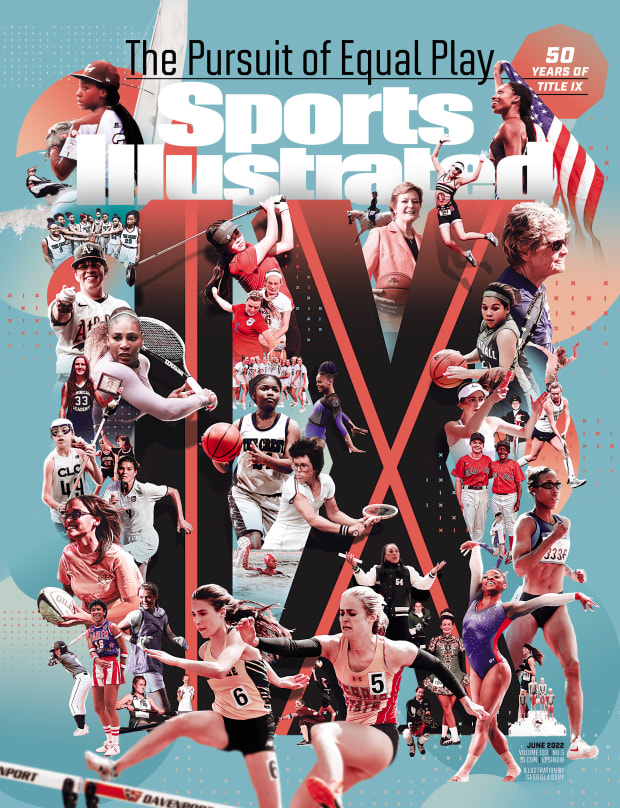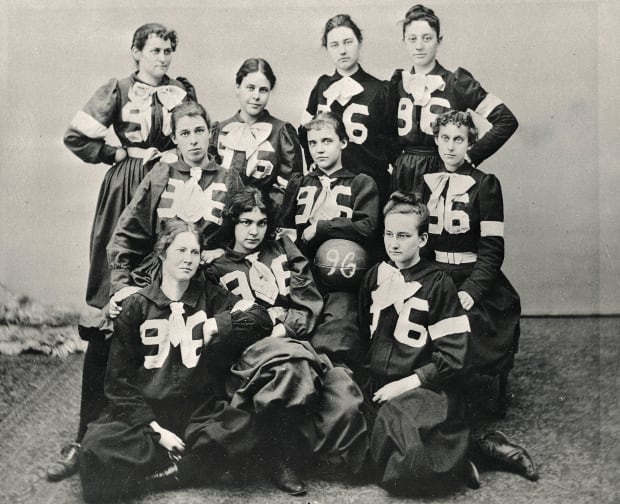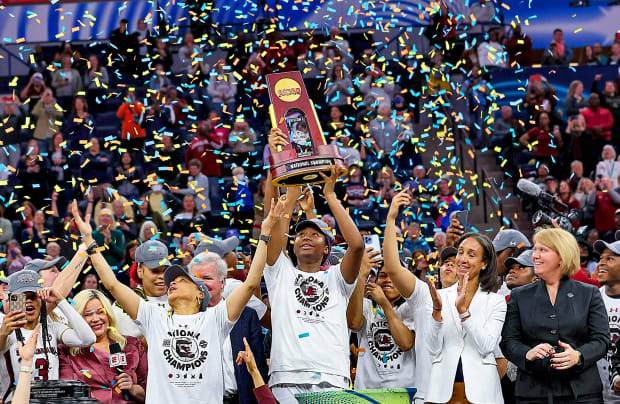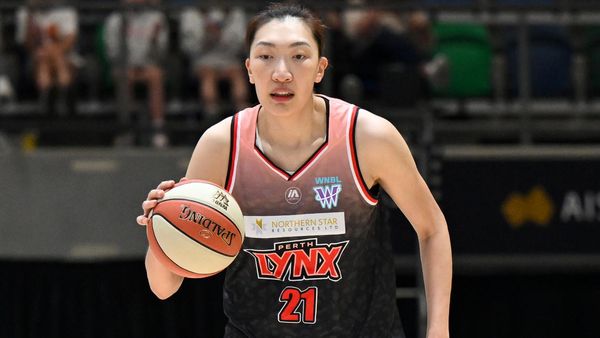For women of my generation, born a decade or more after Title IX was passed, the law had an almost mythical air. I often heard it referred to vaguely to explain why every girl I knew played some kind of sport. I doubt whether anyone my age could quote or explain Title IX, but there was a sense that at some point before us, something had changed that allowed all of us to play sports in ways our mothers mostly hadn’t.
This understanding manifested in many communities as a kind of frenzy when it came to certain girls sports. In my hometown in suburban Seattle, it was soccer. The sport was so popular when I was growing up that I never even made a school team, despite playing from age 6 to 18—the competition was that fierce. It wasn’t for lack of love, though, or competitiveness on my part. I still remember my very first game, bunch-ball though it probably was. I felt like I had been plugged in; energy buzzed through my limbs.
When I didn’t make the school soccer team, I joined cross-country instead, using the endurance I built on the field to race for miles. My friends did track and field, or played softball, basketball or volleyball. Where I grew up, whether you were super athletic, artsy, nerdy, popular, goth or punk, sports were just part of the fabric of our childhoods.
Sometimes, though, we heard whispers of another reality. Just a generation earlier, girls sports in much of the country hadn’t even existed? Women’s bodies were considered too weak to run long distances—so women like Bobbi Gibb and Kathrine Switzer had to sneak into marathons? Women could be rejected from a college because the school had already accepted its quota of two female applicants?

That pre–Title IX world seemed like a fairy tale to me and my friends. But the photos populating this magazine’s cover today are proof of the tidal wave of change that swept across this country over the last 50 years, crashing over my own life and those of countless other women.
On June 23, 1972, then President Richard Nixon signed the Education Amendments Act. The law’s Title IX, which recognized gender equity in education as a civil right, altered women’s sports forever. That massive shift was, in part, an accident. After all, nowhere in the law did the words sport or athletics or even physical education appear.
Instead, the law was written and lobbied for as a means to address vast gender inequality and sex discrimination in education. At the time, college student bodies and faculties were still majority male. In 1970 just 59% of women in the U.S. graduated from high school, and just 8% had college degrees. Institutions like the Cornell School of Veterinary Medicine enrolled only two women a year. Some schools required women to have higher grades than men to be admitted, while others restricted the subjects women could study. When Bernice Sandler, known to her friends as Bunny, finished up her Ed.D. in counseling at the University of Maryland in ’69, she was told she wouldn’t be hired there for a full-time teaching job because she came on “too strong for a woman.” At the time, all of this was legal.
Sandler scoured federal law for some kind of action she could take and found an executive order from then President Lyndon B. Johnson that disallowed discrimination on the basis of sex for organizations that accepted federal contracts—like, for instance, many universities. She gathered examples of discrimination at institutions across the country and shared her research with Representative Edith Green, a Democrat from Oregon, who held seven days of congressional hearings on sex discrimination in education in 1970. The hearings revealed stories of women who weren’t paid to teach because their husbands got a salary, or who were harassed out of engineering programs, or who were told they were too pretty to take difficult classes. These hearings laid the groundwork for Title IX, and Sandler, who died in 2019, became the law’s “godmother.”
But those taking part in the hearings “were absolutely not talking about sports,” says Susan Ware, the author of Title IX: A Brief History With Documents. Not once were women’s college athletics brought up. “The initial supporters [of Title IX] were just as surprised as the athletic departments when it became clear that this law would also apply to sports programs.”
It didn’t take long for sports to become the rallying point to raise support for the new law of the land. While chauvinistic administrations could devise excuses for the lack of women faculty in an English department, funding for school sports was different. “What is so crystal clear about athletics is, you look at these budgets, and if women get 1% of what the men get, it’s such a clear case of discrimination,” Ware says.
Controversy erupted. Men’s coaches and athletic directors claimed equal budgets for men’s and women’s sports would spell the end of men’s sports as we know it. Many schools failed to act until regulations were finalized in 1988, covering athletics and all programs in higher education.

Bettmann/Getty Images
On a spring day in 1893, students at Smith College in Northampton, Mass., filled the gym, dressed in their school colors. Senda Berenson, the director of physical education, had set up a match between the first- and second-year classes at the women’s college, to play a game recently invented by a physical education teacher up the road in Springfield named James Naismith.
Never before had women played a sport like this, in teams. The entire student body turned out to watch the first women’s basketball game.
Nine women on each team stood on the floor wearing bloomers, billowy pants that cut off below the knee and dark stockings pulled up below. Some rolled up their long sleeves to the elbow on thick, dark fabric of their blouses covered by a square sailor-style collar.
The game went on for two 15-minute halves—as per the rules of Naismith’s game, which Berenson had adjusted for her female students. Unlike his version, her players couldn’t dribble more than three times, and running was cut down by having players stay in certain zones of the floor. They shot a soccer ball through two peach baskets pinned to a backboard made of chicken wire. The cheering and screaming of the spectators was a high-pitched sound I do believe no one had ever heard before and was deafening, Berenson remembered later.
The students were hooked.
Each year, the championship game between the school’s best two classes turned out almost the entire campus. Berenson became known as the first expert on women’s basketball. But despite the student body’s enthusiasm for the game, Berenson refused invitations for intercollegiate play. She believed allowing women to play sports as men did—competitively—would become “a menace to real physical education for women.”

Meanwhile, across the country, the women at Stanford, founded in 1891 as a coeducational university, took it upon themselves to set up competitions. Some undergraduates organized a basketball game against Cal in 1896. The teams played in front of a crowd of 500 women—men weren’t allowed to attend—at the San Francisco Armory. Playing by Berenson’s rules, the game ended in a 2–1 Stanford victory. All points were scored on free throws.
But rather than embrace women on campus and the new sport’s glimmer of gender equality, Stanford and other schools retreated, fearing that the increasing number of women enrolling were making the schools too feminized. The school limited female enrollment to 500. Later, when the school was bleeding money during the Great Depression and having to turn away thousands of qualified female applicants each year, they changed the cap to a gender ratio: 60% men and 40% women.
Like many big universities looking for a higher profile in the early 20th century, Stanford doubled down on its masculine ideology and turned its attention toward bolstering its men’s athletic programs. Women undergraduates hated the new system of having only what the school called “sociable play days.” They wanted real competition and a new gym. By 1947 the women’s physical education department allowed intercollegiate sports for women but offered very little funding.
In 1974, two years after the passage of Title IX, Mariah Burton Nelson accepted an offer of admission from Stanford, eager to play college basketball. “I knew Stanford did not have a strong program and said so to Fred Hargadon, then the dean of admissions, who recruited me,” Nelson says. “He told me he wanted me ‘to help build the program.’ ”
Coached by a volunteer graduate student, the team played in a tiny practice gym where 20 or so fans would watch games from a single bench. They wore white T-shirts with masking-taped numbers as uniforms. The team wasn’t allowed to use the weight room. While they played an 11-game season, the Stanford men’s team played 25 games in a brand-new gym, Maples Pavilion, and most of the team had full scholarships.
Though the enforcement guidelines for Title IX in sports had yet to be finalized, the new law was a fillip. Nelson and two teammates, Sonia Jarvis and Stephanie Erickson, staged three-person sit-ins in the athletic director’s office, refusing to leave until he heard their demands for the same resources the men had. By Nelson’s junior year, the athletic department had hired two paid women’s basketball coaches, Dotty McCrea and Sue Rojcewicz. Players received real uniforms, access to the weight room and they got to play in “the men’s gym.” By her senior year, they even had a scholarship athlete.

Elsa/Getty Images
The snowball Nelson pushed down from the top of the mountain at Stanford gained momentum quickly. McCrea and Rojcewicz remained at the school until 1985, when Stanford hired Tara VanDerveer. Five years later, Stanford won its first women’s basketball national championship. Today, VanDerveer has the most wins in women’s college basketball history and is paid upward of $2 million a year. She took home the 2021 title in front of four million TV viewers, more than the average NBA playoff game. And this year’s NCAA women’s basketball tournament was expanded to a 68-team field (equal to the men’s) and used the March Madness branding for the first time.
Progress, when it comes to Title IX, can seem obvious. It’s easy to imagine that it might also be bittersweet for athletes of earlier eras to see today’s women have opportunities they never had. Yet to Nelson, this vastly different world doesn’t cast a shadow over her own experience—it brings her joy. When Stanford loses, her friends check in to see whether she’s upset. “Heck no. Women’s basketball itself is winning. That’s what I’m rooting for,” she says.
The pursuit of equality is more like an ultramarathon than a road race. There are twists and turns and long stretches when we aren’t sure we’re going in the right direction. Even today, athletic opportunities at most schools are still not equitable. “The amount of change in women’s sports really is transformational,” says Ware. “But it started from zero; that’s the perspective, so getting to 40% [of athletic budgets], that’s a lot of progress—the needle just got stuck.”
When Nelson spoke at a Title IX anniversary event at the Tucker Center for Research on Girls & Women in Sport at the University of Minnesota in 2002, she cited the need for fairer implementation of the law. The campus newspaper covering the event quoted a men’s wrestling coach who wasn’t pleased with her speech. “A lot of the stuff is very slanted. . . . The Tucker Center has an agenda. The feminist agenda doesn’t look at the data: Title IX is killing men’s sports,” he said.
Two decades later that fear is still well worn, with athletic directors and coaches from 1972 to today claiming that big moneymakers for schools like men’s football and basketball shouldn’t have to share money with less profitable (read: women’s) sports. According to a 2022 report from the Pew Research Center, men are more likely than women to say funding should be based on the amount of money brought in by the team (30% vs. 14%, respectively). Even now, says Ware, often when she discusses Title IX compliance, it’s presented like a zero-sum game: “If women win, then men lose. And Title IX gets blamed for everything, especially in the athletic department when there are hard choices that need to be made.”
When Title IX was passed, even high-level intercollegiate sports were often niche and regionally popular. Today, college sports are a multibillion-dollar fixture of the national sports entertainment industry—and a source of complaints about excess commercialization, abuse of an unpaid labor force and of academic institutions allowing a cash spigot to take them far away from their educational mission.
Here, too, Title IX plays a role. The legal requirement to field women’s teams gives universities cover for the commercialization of football and other men’s programs. In some cases, the law “has provided a shield of the ratcheting up of making money to subsidize other sports,” says Victoria Jackson, a historian at Arizona State and former professional runner.
As college athletes have won the right to be paid through name, image and likeness deals, one thing that’s become clear is women’s teams may be worth more than we’ve been led to believe. How else do you explain women’s college basketball ranking second in NIL deals, behind football, according to a study by NIL company Opendorse?

David E. Klutho/Sports Illustrated
Even if athletic budgets at every school in the nation was equal for men and women, there still wouldn’t be true equal access. High schools in this country are still largely racially segregated, and those with majority students of color have fewer resources and sports teams. Even at majority-white schools, girls typically have only 82% of the sports opportunities that boys have; at schools where students of color make up the majority, that number drops to 67%, according to the National Women’s Law Center.
A 1973 article in this magazine detailed the vast inequities faced by women athletes. In some ways, it sounds like ancient history: A 1969 Syracuse school budget earmarked $90,000 for boys sports and $200 for girls.
The article goes on to describe an account from LPGA golfer Jo Ann Prentice, on the gossip about her sex life: “The vicious paradox that Prentice outlines—women athletes are either heterosexual wantons or homosexual perverts or, simultaneously, both—is the culmination of all the jokes and warnings that began when an 11-year-old wanted to play sandlot football with her brother and was teased, in good fun, about being a tomboy.”
While progress in funding for women’s athletic programs is easy to gauge, more difficult are those attitudes toward women athletes: the old, offensive stereotypes holding that they must be unnatural in some way and are certainly not to be deified in the same way we do men.
In professional sports, this tension plays out constantly. The U.S. women’s national soccer team took its own employer to court over equal pay, reaching a settlement in 2022 after years of wrangling and, in May, agreeing to a landmark deal that equalizes World Cup prize money. The WNBA prohibits charter flights to away games. And the NWSL has been embroiled in controversy over widespread allegations of abuse, harassment and low pay.
In the college basketball ranks, it took Sedona Prince’s now infamous TikTok video to expose the inequities in the facilities. Nearly 50 years after Nelson’s team at Stanford was denied access to the weight room, the treatment was essentially the same. But this time, people cared.
Though not universal, maybe it’s these shifts in how women are viewed that are the truly celebratory results of Title IX. Women can be record breakers, broadcasters and coaches. Women’s teams can make money. Women deserve respect no matter what they choose to study, teach or play, or whether they’re gay, straight, bi or trans.
Title IX has never been and never will be just about sports. But women’s sports have never been just about sports, either. As anyone who’s played or watched knows—it’s about a whole lot more.







